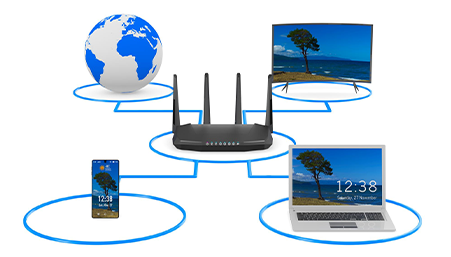


Internet bandwidth, a critical component of your internet connection, is often misunderstood. It plays a pivotal role in determining the performance of your online activities. Understanding the differences between as bandwidth vs internet speed and the types of bandwidth available, can lead to an optimised online experience, especially with fibre optic bandwidth offering high-speed possibilities.
Here, we will cover the significance of internet bandwidth, explore the difference between bandwidth vs internet speed, touch on types of bandwidth, and emphasise why a robust internet connection is essential.
Internet bandwidth is like the highway that allows data to travel between your device and the internet. It represents the maximum amount of data transmitted over an internet connection in a given time frame. This is typically measured in megabits per second (Mbps) or gigabits per second (Gbps). You can think of it as the width of a pipe; the wider the pipe (higher bandwidth), the more data can flow through at once.
Bandwidth and Internet speed are distinct concepts. Bandwidth is like a highway's capacity, while internet speed is how fast the vehicles (data) travel on it. Imagine you have a highway (bandwidth) with multiple lanes. If you are driving a sports car (high-speed internet), you will move quickly. However, even with a wide highway (ample bandwidth), your data will move slower if you are driving a slower car (low-speed internet). So, bandwidth defines potential, while internet speed determines the actual data transfer rate. Check your internet speed here.
Bandwidth refers to the capacity of an internet connection to transmit data, and it comes in two primary types: asymmetric and symmetric.
1. Asymmetric Bandwidth: This is the more common type in residential and small business settings. It offers different upload and download speeds. Typically, the download speed is higher, catering to web browsing, streaming, and downloading content. The upload speed is slower but sufficient for tasks like sending emails. Asymmetric bandwidth is cost-effective for consumer needs but may not be ideal for businesses requiring consistent, high-speed uploads.
2. Symmetric Bandwidth: Symmetric connections offer equal upload and download speeds. This type is crucial for businesses, especially those needing to transfer large files, engage in video conferencing, or host websites and servers. It ensures efficient data transmission in both directions, providing a more reliable and balanced internet experience. While symmetric bandwidth is more expensive, it's necessary for businesses with demanding online operations.
| BROADBAND TYPE | ADVANTAGES | DISADVANTAGES |
|---|---|---|
| DSL | Widely available | Slower speeds compared to other options |
| Stable connection | Speed may decrease with distance from the central office | |
| Affordable | ||
| CABLE | Stable connection | Connection can slow during peak hours |
| Faster speeds than DSL | Reliability may vary | |
| Shared connection with neighbours | ||
| FIBRE OPTIC | Ultra-fast speeds | Limited availability in some areas |
| Low latency | Installation can be expensive | |
| Symmetrical upload and download speeds | ||
| SATELLITE | Accessible in remote areas | High latency can impact real-time tasks |
| No need for physical infrastructure | Data caps and fair usage policies |
Each bandwidth type has unique advantages, and the choice depends on factors like location, budget, and specific requirements.
| USER TYPE | RECOMMENDED SPEED |
|---|---|
| HOUSEHOLD | |
| Small Household (1-3 users) | 25-50 Mbps |
| Medium Household (4-6 users) | 50-100 Mbps |
| Large Household (7+ users) | 100+ Mbps |
| SMALL AND MEDIUM-SIZED ENTERPRISES | |
| Small Office (1-10 employees) | 50-100 Mbps |
| Medium Office (11-50 employees) | 100-500 Mbps |
| Larger Office (51+ employees) | 500+ Mbps |
| FREELANCERS | |
| Basic Usage | 25-50 Mbps |
| Moderate Usage (e.g., frequent video calls, large file transfers) | 50-100 Mbps |
| Heavy Usage (e.g., data-intensive work or media production) | 100+ Mbps |
| WORK-FROM-HOME PROFESSIONALS | |
| Basic Remote Work | 25-50 Mbps |
| Moderate Remote Work (frequent video conferencing) | 50-100 Mbps |
| Intensive Remote Work (e.g., software development, design) | 100+ Mbps |
| GAMERS | |
| Casual Gaming | 10-20 Mbps |
| Online Multiplayer Gaming | 20-50 Mbps |
| Competitive Gaming (low latency is crucial) | 50+ Mbps |
| BINGE WATCHING | |
| Standard Definition (SD) | 3-4 Mbps per device |
| High Definition (HD) | 5-10 Mbps per device |
| 4K Ultra HD | 25 Mbps or more per device |
The acronym Mbps stands for "megabits per second." It is a measure of internet bandwidth. In simple terms, bandwidth is the download rate of your internet connection. It is the maximum speed at which you can download data from the internet onto your computer or mobile device.
An internet connection with a speed of at least 25Mbps is suitable for WiFi. This will ensure multiple people get adequate internet bandwidth on your WiFi network while multiple devices are used simultaneously. For larger households, a speed of 100Mbps is even better.
Under ideal conditions, a 2.4 GHz WiFi router can support speeds up to 450 Mbps, some up to 600 Mbps. Meanwhile, a 5 GHz WiFi router can reach up to 1300 Mbps. These figures depend on your internet connection and internet bandwidth.

